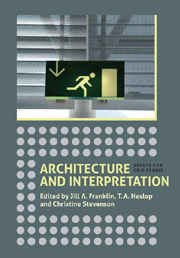Book contents
- Frontmatter
- Contents
- List of Illustrations
- Preface: In Appreciation
- List of contributors
- 1 Introduction
- Incitements to Interpret in Late Antique and Medieval Architecture
- Authors and Intentions
- Architecture beyond Building
- 266 Innovation and Traditionalism in Writings on English Romanesque
- 284 Why Medieval Ireland Failed to Edify
- 306 The Chapel of the Hospital of Saint-Jean at Angers: Acta, Statutes, Architecture and Interpretation
- 315 Sealed Architecture: City Seals, Architecture and Urban Identity in the Northern Netherlands, 1200–1700
- 333 Style and Geography: Struggles for Identification in the Later Nineteenth Century
- 343 The Dome of the Rock: From Medieval Symbol to Modern Propaganda
- 357 Towards a Cultural Geography of Modern Memorials
- 381 Bicycle Sheds Revisited, Or: Why are Houses Interesting?
- Index
284 - Why Medieval Ireland Failed to Edify
from Architecture beyond Building
Published online by Cambridge University Press: 05 April 2013
- Frontmatter
- Contents
- List of Illustrations
- Preface: In Appreciation
- List of contributors
- 1 Introduction
- Incitements to Interpret in Late Antique and Medieval Architecture
- Authors and Intentions
- Architecture beyond Building
- 266 Innovation and Traditionalism in Writings on English Romanesque
- 284 Why Medieval Ireland Failed to Edify
- 306 The Chapel of the Hospital of Saint-Jean at Angers: Acta, Statutes, Architecture and Interpretation
- 315 Sealed Architecture: City Seals, Architecture and Urban Identity in the Northern Netherlands, 1200–1700
- 333 Style and Geography: Struggles for Identification in the Later Nineteenth Century
- 343 The Dome of the Rock: From Medieval Symbol to Modern Propaganda
- 357 Towards a Cultural Geography of Modern Memorials
- 381 Bicycle Sheds Revisited, Or: Why are Houses Interesting?
- Index
Summary
THE VISUAL AND MATERIAL CULTURE of medieval Ireland is far from a neglected area: indeed, with the constant expansion of the road network, man-made objects and landscapes are brought to the public's attention in the most dramatic as well as most humdrum ways, through court cases, media coverage, traffic jams, academic petitions and governmental propaganda. Yet despite this ongoing spectacle of discovery, the study of Ireland's medieval built environment is far from high-profile, while within the academic disciplines, there is a subtle but perceptible friction between art history and archaeology. Given Eric Fernie's contribution to, and continuing interest in, debates on the crossovers between these disciplines, it seems pertinent here to explore the problems and pitfalls of studying Ireland's medieval buildings as architecture. Architectural historians have generally eschewed their study, and the perception has been that they are marginal to the history of European architecture. This apparent marginality is one with which Irish history more generally has also to contend, except perhaps for the period of the sixth and seventh centuries. This paper aims to trace some of the reasons for such perceived irrelevance through a brief historiographic survey, to suggest that a more open theoretical model might allow the reintegration of Irish medieval buildings into their European context, and to raise the problem of modern subjective experiential alienation from such built forms. It is not so much that exciting interpretations of Irish architecture are not being written, as that they are failing to be incorporated into the discourse outside a very limited sphere of specialist writing.
- Type
- Chapter
- Information
- Architecture and InterpretationEssays for Eric Fernie, pp. 284 - 305Publisher: Boydell & BrewerPrint publication year: 2012

